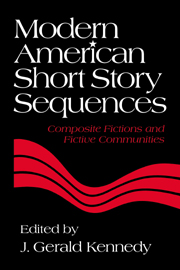Book contents
- Frontmatter
- Contents
- Contributors
- Introduction: The American Short Story Sequence – Definitions and Implications
- Henry James's Incipient Poetics of the Short Story Sequence: The Finer Grain (1910)
- Toomer's Cane as Narrative Sequence
- Hemingway's In Our Time: The Biography of a Book
- Wright Writing Reading: Narrative Strategies in Uncle Tom's Children
- The African-American Voice in Faulkner's Go Down, Moses
- Meditations on Nonpresence: Re-visioning the Short Story in Eudora Welty's The Wide Net
- Nine Stories: J. D. Salinger's Linked Mysteries
- Cheever's Shady Hill: A Suburban Sequence
- John Updike's Olinger Stories: New Light Among the Shadows
- Louise Erdrich's Love Medicine: Narrative Communities and the Short Story Sequence
- From Anderson's Winesburg to Carver's Cathedral: The Short Story Sequence and the Semblance of Community
- Index
John Updike's Olinger Stories: New Light Among the Shadows
Published online by Cambridge University Press: 29 September 2009
- Frontmatter
- Contents
- Contributors
- Introduction: The American Short Story Sequence – Definitions and Implications
- Henry James's Incipient Poetics of the Short Story Sequence: The Finer Grain (1910)
- Toomer's Cane as Narrative Sequence
- Hemingway's In Our Time: The Biography of a Book
- Wright Writing Reading: Narrative Strategies in Uncle Tom's Children
- The African-American Voice in Faulkner's Go Down, Moses
- Meditations on Nonpresence: Re-visioning the Short Story in Eudora Welty's The Wide Net
- Nine Stories: J. D. Salinger's Linked Mysteries
- Cheever's Shady Hill: A Suburban Sequence
- John Updike's Olinger Stories: New Light Among the Shadows
- Louise Erdrich's Love Medicine: Narrative Communities and the Short Story Sequence
- From Anderson's Winesburg to Carver's Cathedral: The Short Story Sequence and the Semblance of Community
- Index
Summary
In his essay “Why Write?” John Updike recounts a childhood pastime that involved drawing assorted objects on a sheet of paper and then connecting them with lines “so that they all became the fruit of a single impossible tree.” Such an activity, Updike continues, may be “as deep … as the urge to hear a story from beginning to end, or the little ecstasy of extracting resemblances from different things”; both playful and artistic, this childhood pleasure recurs when he fashions “several disparate incidents or impressions into the shape of a single story.” Essential to creativity, the connecting impulse not only recalls childhood happiness but also produces meaningful fictional patterns that link past and present, a central concern in Updike's writing, especially at the time Olinger Stories was published. As his fictional locale undergoes a shift from the rural Olinger of his youth to suburban Tarbox, the search for continuity in, and connection with, a receding past assumes increasing thematic importance and achieves formal realization in the gathering of the Olinger stories into a single volume whose composite structure reflects the splintered recall of the past as well as the attempt to fashion a new order that counters time's erosion.
Updike's description of the connective or pattern-making faculty relates to the complementary forces that unite all works of fiction: linear or diachronic unity – the force behind narrative continuity – and associative or synchronic unity, a looser but still powerful mode of coherence.
- Type
- Chapter
- Information
- Modern American Short Story SequencesComposite Fictions and Fictive Communities, pp. 151 - 169Publisher: Cambridge University PressPrint publication year: 1995



